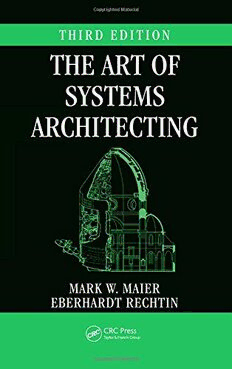
The Art of Systems Architecting, Third Edition PDF
Preview The Art of Systems Architecting, Third Edition
T H I R D E D I T I O N THE ART OF SYSTEMS ARCHITECTING T H I R D E D I T I O N THE ART OF SYSTEMS ARCHITECTING MARK W. MAIER EBERHARDT RECHTIN Boca Raton London New York CRC Press is an imprint of the Taylor & Francis Group, an informa business CRC Press Taylor & Francis Group 6000 Broken Sound Parkway NW, Suite 300 Boca Raton, FL 33487-2742 © 2009 by Taylor & Francis Group, LLC CRC Press is an imprint of Taylor & Francis Group, an Informa business No claim to original U.S. Government works Printed in the United States of America on acid-free paper 10 9 8 7 6 5 4 3 2 1 International Standard Book Number-13: 978-1-4200-7913-5 (Hardcover) This book contains information obtained from authentic and highly regarded sources. Reasonable efforts have been made to publish reliable data and information, but the author and publisher can- not assume responsibility for the validity of all materials or the consequences of their use. The authors and publishers have attempted to trace the copyright holders of all material reproduced in this publication and apologize to copyright holders if permission to publish in this form has not been obtained. If any copyright material has not been acknowledged please write and let us know so we may rectify in any future reprint. Except as permitted under U.S. Copyright Law, no part of this book may be reprinted, reproduced, transmitted, or utilized in any form by any electronic, mechanical, or other means, now known or hereafter invented, including photocopying, microfilming, and recording, or in any information storage or retrieval system, without written permission from the publishers. For permission to photocopy or use material electronically from this work, please access www.copy- right.com (http://www.copyright.com/) or contact the Copyright Clearance Center, Inc. (CCC), 222 Rosewood Drive, Danvers, MA 01923, 978-750-8400. CCC is a not-for-profit organization that pro- vides licenses and registration for a variety of users. For organizations that have been granted a photocopy license by the CCC, a separate system of payment has been arranged. Trademark Notice: Product or corporate names may be trademarks or registered trademarks, and are used only for identification and explanation without intent to infringe. Library of Congress Cataloging-in-Publication Data Maier, Mark. The art systems of architecting / Mark W. Maier. -- 3rd ed. p. cm. Includes bibliographical references and index. ISBN 978-1-4200-7913-5 (alk. paper) 1. Systems engineering. I. Title. TA168.M263 2009 620.001’171--dc22 2008044161 Visit the Taylor & Francis Web site at http://www.taylorandfrancis.com and the CRC Press Web site at http://www.crcpress.com To Eberhardt Rechtin, who opened new vistas to so many of us, and inspired us to go out and find more. Mark Maier Contents Preface ................................................................................................................xv Part I: Introduction A Brief Review of Classical Architecting Methods .......................................1 Notes ....................................................................................................................4 Chapter 1 Extending the Architecting Paradigm ....................................5 Introduction: The Classical Architecting Paradigm .....................................5 Responding to Complexity ...............................................................................5 The High Rate of Advances in the Computer and Information Sciences ...7 The Foundations of Modern Systems Architecting ......................................8 The Architecture Paradigm Summarized ....................................................19 The Waterfall Model of Systems Acquisition ...............................................20 Spirals, Increments, and Collaborative Assembly .......................................23 Scopes of Architecting .....................................................................................25 Conclusion .........................................................................................................27 Notes and References ......................................................................................27 Chapter 2 Heuristics as Tools ....................................................................29 Introduction: A Metaphor ...............................................................................29 Heuristics as Abstractions of Experience .....................................................30 Selecting a Personal Kit of Heuristic Tools ..................................................31 Using Heuristics ...............................................................................................34 A Process Framework for Architecting Heuristics .....................................35 Heuristics on Heuristics ..................................................................................38 A Taxonomy of Heuristics ..............................................................................39 New Directions.................................................................................................41 Conclusion .........................................................................................................41 Notes and References ......................................................................................42 viii Contents Part II: New Domains, New Insights Case Study 1: DC-3 .........................................................................................47 The History .......................................................................................................47 Architecture Interpretation ............................................................................51 Three Story Variations .....................................................................................51 Was the Boeing 247 Successfully Architected? ............................................52 What Is the “Architecture” of the DC-3? ......................................................53 Art Raymond’s Principles ...............................................................................53 Notes and References ......................................................................................55 Chapter 3 Builder-Architected Systems ..................................................57 Introduction: The Form-First Paradigm .......................................................57 Technological Substitutions within Existing Systems ................................59 Consequences of Uncertainty of End Purpose ............................................61 Architecture and Competition .......................................................................61 Reducing the Risks of Uncertainty of End Purpose ...................................63 Risk Management by Intermediate Goals ....................................................64 The “What Next?” Quandary .........................................................................65 Controlling the Critical Features of the Architecture.................................66 Abandonment of an Obsolete Architecture .................................................67 Creating Innovative Teams .............................................................................68 Architecting “Revolutionary” Systems .........................................................70 Systems Architecting and Basic Research ....................................................72 Heuristics for Architecting Technology-Driven Systems ..........................73 Conclusion .........................................................................................................74 Exercises ............................................................................................................74 Notes and References ......................................................................................75 Case Study 2: Mass and Lean Production ..................................................77 Introduction ......................................................................................................77 An Architectural History of Mass Production ............................................77 Cottage Industry (1890s to 1910s) ...................................................................78 Birth of Mass Production (1908–1913) ...........................................................78 Competition from New Quarters (1920s to 1930s) .......................................79 The Toyota Production System (1940s to 1980s) ...........................................80 Metaphor or Vision Changes ..........................................................................81 Craftsmen ..........................................................................................................81 A Car for the Masses, or If We Build It, It Will Sell .....................................81 Cars as Fashion .................................................................................................82 The Supermarket Metaphor ...........................................................................82 The Toyota Way ................................................................................................82 Elements of the Architecture of the Ford Production System ...................82 The Assembly Line ..........................................................................................83 Contents ix Enterprise Distribution ...................................................................................83 Management Processes ...................................................................................84 Quality Assurance for Distributed Production ...........................................84 Devotion to Component-Level Simplification..............................................84 Social Contract ..................................................................................................85 Conclusion .........................................................................................................85 Notes and References ......................................................................................86 Chapter 4 Manufacturing Systems ..........................................................87 Introduction: The Manufacturing Domain ..................................................87 Manufacturing in Context ..............................................................................88 Architectural Innovations in Manufacturing ..............................................91 Dynamic Manufacturing Systems .................................................................93 Lean Production .............................................................................................105 Flexible Manufacturing .................................................................................108 Heuristics for Architecting Manufacturing Systems.................................111 Conclusion ........................................................................................................111 Exercises ..........................................................................................................112 Notes and References ....................................................................................112 Case Study 3: Intelligent Transportation Systems .................................115 Introduction .....................................................................................................115 ITS Concepts ....................................................................................................116 ITS Sociotechnical Issues ...............................................................................118 Who Is the Client for an Architect? ..............................................................118 Public or Private? .............................................................................................119 Facts and Perceptions ....................................................................................121 Architecture as Shared Invariants ...............................................................122 Dominance of Economics .............................................................................122 Notes and References ....................................................................................123 Chapter 5 Social Systems .........................................................................125 Introduction: Defining Sociotechnical Systems ........................................125 Public Participation ........................................................................................125 The Foundations of Sociotechnical Systems Architecting .......................127 The Separation of Client and User ...............................................................127 Socioeconomic Insights .................................................................................128 The Interaction between the Public and Private Sectors ..........................130 Facts versus Perceptions: An Added Tension ............................................131 Heuristics for Social Systems .......................................................................134 Conclusion .......................................................................................................135 Exercises ..........................................................................................................135 Notes and References ....................................................................................136
